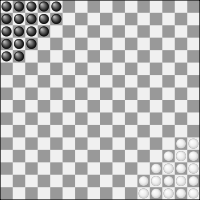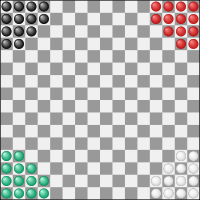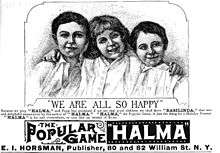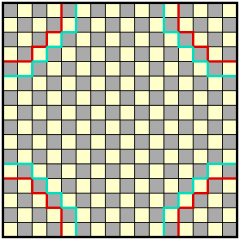Halma
|
Board with "camps" marked for two players (blue) and four players (red) | |
| Years active | 1883/84 to present |
|---|---|
| Genre(s) |
Board game Abstract strategy game |
| Players | 2 or 4 |
| Setup time | ~1 minute |
| Playing time | 10 minutes to 1 or more hours |
| Random chance | None |
| Skill(s) required | Strategy, tactics |
Halma (from the Greek word ἅλμα meaning "jump") is a strategy board game invented in 1883 or 1884 by George Howard Monks, a US thoracic surgeon at Harvard Medical School. His inspiration was the English game Hoppity which was devised in 1854.[1]
The gameboard is checkered and divided into 16×16 squares. Pieces may be small checkers or counters, or wooden or plastic cones or men resembling small chess pawns.[2] Piece colors are typically black and white for two-player games, and various colors or other distinction in games for four players.
Overview
The game is played by two or four players seated at opposing corners of the board. The game is won by being first to transfer all of one's pieces from one's own camp into the camp in the opposing corner. For four-player games played in teams, the winner is the first team to race both sets of pieces into opposing camps. On each turn, a player either moves a single piece to an adjacent open square, or jumps over one or more pieces in sequence.
Rules
Setup



- The board consists of a grid of 16×16 squares.
- Each player's camp consists of a cluster of adjacent squares in one corner of the board. These camps are delineated on the board.
- For two-player games, each player's camp is a cluster of 19 squares. The camps are in opposite corners.
- For four-player games, each player's camp is a cluster of 13 squares. Each of the four corners of the board is a camp.
- Each player has a set of pieces in a distinct color, of the same number as squares in each camp.
- The game starts with each player's camp filled by pieces of their own color.
Play sequence

- Players randomly determine who will move first.
- Pieces can move in eight possible directions (orthogonally and diagonally).
- Each player's turn consists of moving a single piece of one's own color in one of the following plays:
- One move to an empty square:
- Place the piece in an empty adjacent square.
- This move ends the play.
- One or more jumps over adjacent pieces:
- An adjacent piece of any color can be jumped if there is an adjacent empty square on the directly opposite side of that piece.
- Place the piece in the empty square on the opposite side of the jumped piece.
- The piece that was jumped over is unaffected and remains on the board.
- After any jump, one may make further jumps using the same piece, or end the play.
- One move to an empty square:
- Once a piece has reached the opposing camp, a play cannot result in that piece leaving the camp.
- If the current play results in having every square of the opposing camp occupied by one's own pieces, the acting player wins. Otherwise, play proceeds clockwise around the board.
Comparison to other games
- The mechanic of jumping pieces is reminiscent of draughts (checkers) but differs in that no opposing pieces are ever captured or otherwise withdrawn from the board nor is jumping compulsory.
- Chinese Checkers, a variant of Halma, was originally published in 1892 as Stern-Halma (German for "Star Halma") and later renamed upon marketing to the United States to appear more exotic. The name is misleading, since the game has no historical connection with China, nor is it a checkers game.
Variations
There are also 8×8 and 10×10 board variations, either of which is adequate for two players and they have 10 and 15 pieces per player, respectively. There are various on-line versions on the internet, usually for two-player, turn based play.
Some sites implement a rule variation stating that a player automatically loses if they still have a piece in their start region after a certain number of moves (typically 30 for the 8×8 game, 50 for the 10×10 game). Fast-advancing players occasionally attempt to blockade an opposing piece, but this tactic can backfire if the other player is aware of it. In non-electronic versions, the number of moves is not normally counted.
Basic strategy and tactics
A game of Halma has three distinct phases. The beginning (before opposing pieces come into contact) is usually a set-piece battle, with players setting up their favoured openings. The middle (when opposing pieces are blocking or jumping each other) is usually characterised by opportunistic play; the player with the most patience to check the whole board for opportunities, including those gained by moving backwards in order to move forwards, will gain an advantage. Players should also set up for the endgame (when opposing pieces have passed one another and must run for home), avoiding stragglers.
As with most board games, early control of the center is a key tactic, as it provides additional mobility. Pieces can form a two-layer blocking wall, deflecting the opponent from the center and forcing them into a longer trajectory; however, if the opponent builds an adjacent wall, then the first player to disband his wall usually suffers a strategic disadvantage.
It is important to understand that paired pieces move faster than single pieces in the endgame. This means that a player with a pair of "leapfrogging" pieces has an advantage over a player with two individual stragglers.
The larger boards have more strategic combinations available than the smaller boards, and the four player game offers more tactical intrigue than the two player game.
Notable appearances in popular culture

- Talking Halma pieces featured in the Rupert the Bear story "Rupert and the Jumping Men," Rupert Annual 1976.[3]
- In E. Nesbit's The Magic City, the land of Somnolentia is inhabited by Halma people.
- Mervyn Peake twice compares distant people to halma pieces, in his novels Mr Pye and Titus Groan.
- Paul Jennings described the hilarious results of his attempt to decipher the rules of the game from a set of instructions in German in his article "How to Spiel Halma".
- Eleanor Farjeon talks about playing Halma in her autobiography A Nursery in the Nineties, and about using black, white and red Halma pieces to enact a Christmas Eve ritual game in which imaginary characters try to climb a mountain made of Anchor Stone Blocks.
- In the The Chalet School and Jo from the Chalet School series by Elinor Brent-Dyer, Halma is played by two of the characters.
See also
References
- ↑ Brian Love, Great Board Games, London, (1979), p. 5
- ↑ Diagram Group (1975), p. 42
- ↑ "Rupert Bear and the Jumping Men. Where have all the games gone?"
Bibliography
- Diagram Group (1975). Midgley, Ruth, ed. The Way to Play. Paddington Press Ltd. ISBN 0-8467-0060-3.
- Whitehill, Bruce. "Halma and Chinese Checkers: Origins and Variations." Fribourg, Switzerland: Step by Step, Proceedings of the 4th Colloquium of Board Games in Academia, Editions Universitaires Fribourg, 2002.
Further reading
External links
- "Halma" for Android
- Rules for the Game of Halma, Copyright 1938 by Parker Brothers, Inc. Salem, Mass., New York, Chicago and London
- Halma at BoardGameGeek
